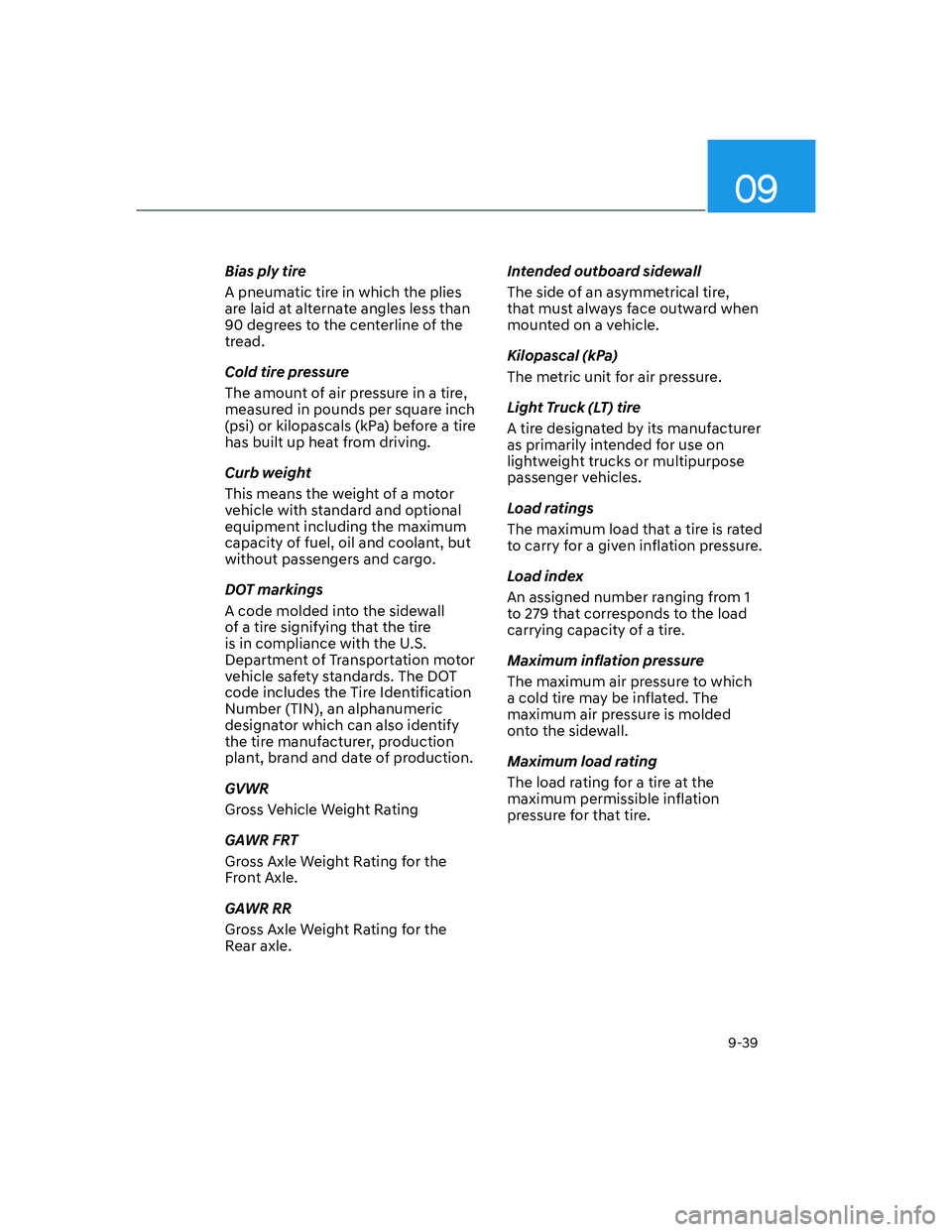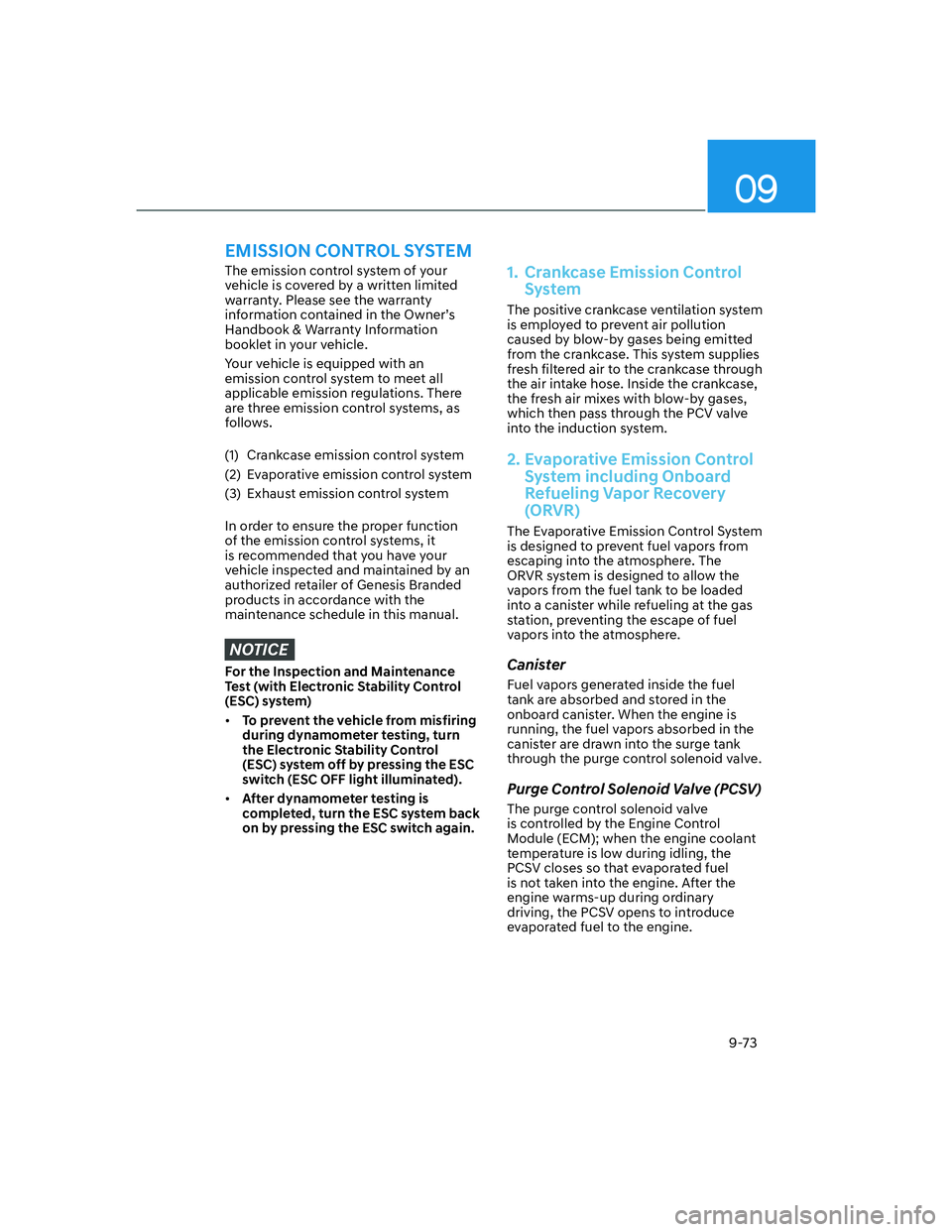Page 596 of 647

09
9-39
Bias ply tire
A pneumatic tire in which the plies
are laid at alternate angles less than
90 degrees to the centerline of the
tread.
Cold tire pressure
The amount of air pressure in a tire,
measured in pounds per square inch
(psi) or kilopascals (kPa) before a tire
has built up heat from driving.
Curb weight
This means the weight of a motor
vehicle with standard and optional
equipment including the maximum
capacity of fuel, oil and coolant, but
without passengers and cargo.
DOT markings
A code molded into the sidewall
of a tire signifying that the tire
is in compliance with the U.S.
Department of Transportation motor
vehicle safety standards. The DOT
code includes the Tire Identification
Number (TIN), an alphanumeric
designator which can also identify
the tire manufacturer, production
plant, brand and date of production.
GVWR
Gross Vehicle Weight Rating
GAWR FRT
Gross Axle Weight Rating for the
Front Axle.
GAWR RR
Gross Axle Weight Rating for the
Rear axle.Intended outboard sidewall
The side of an asymmetrical tire,
that must always face outward when
mounted on a vehicle.
Kilopascal (kPa)
The metric unit for air pressure.
Light Truck (LT) tire
A tire designated by its manufacturer
as primarily intended for use on
lightweight trucks or multipurpose
passenger vehicles.
Load ratings
The maximum load that a tire is rated
to carry for a given inflation pressure.
Load index
An assigned number ranging from 1
to 279 that corresponds to the load
carrying capacity of a tire.
Maximum inflation pressure
The maximum air pressure to which
a cold tire may be inflated. The
maximum air pressure is molded
onto the sidewall.
Maximum load rating
The load rating for a tire at the
maximum permissible inflation
pressure for that tire.
Page 630 of 647

09
9-73
The emission control system of your
vehicle is covered by a written limited
warranty. Please see the warranty
information contained in the Owner’s
Handbook & Warranty Information
booklet in your vehicle.
Your vehicle is equipped with an
emission control system to meet all
applicable emission regulations. There
are three emission control systems, as
follows.
(1) Crankcase emission control system
(2) Evaporative emission control system
(3) Exhaust emission control system
In order to ensure the proper function
of the emission control systems, it
is recommended that you have your
vehicle inspected and maintained by an
authorized retailer of Genesis Branded
products in accordance with the
maintenance schedule in this manual.
NOTICE
For the Inspection and Maintenance
Test (with Electronic Stability Control
(ESC) system)
• To prevent the vehicle from misfiring
during dynamometer testing, turn
the Electronic Stability Control
(ESC) system off by pressing the ESC
switch (ESC OFF light illuminated).
• After dynamometer testing is
completed, turn the ESC system back
on by pressing the ESC switch again.
1. Crankcase Emission Control
System
The positive crankcase ventilation system
is employed to prevent air pollution
caused by blow-by gases being emitted
from the crankcase. This system supplies
fresh filtered air to the crankcase through
the air intake hose. Inside the crankcase,
the fresh air mixes with blow-by gases,
which then pass through the PCV valve
into the induction system.
2. Evaporative Emission Control
System including Onboard
Refueling Vapor Recovery
(ORVR)
The Evaporative Emission Control System
is designed to prevent fuel vapors from
escaping into the atmosphere. The
ORVR system is designed to allow the
vapors from the fuel tank to be loaded
into a canister while refueling at the gas
station, preventing the escape of fuel
vapors into the atmosphere.
Canister
Fuel vapors generated inside the fuel
tank are absorbed and stored in the
onboard canister. When the engine is
running, the fuel vapors absorbed in the
canister are drawn into the surge tank
through the purge control solenoid valve.
Purge Control Solenoid Valve (PCSV)
The purge control solenoid valve
is controlled by the Engine Control
Module (ECM); when the engine coolant
temperature is low during idling, the
PCSV closes so that evaporated fuel
is not taken into the engine. After the
engine warms-up during ordinary
driving, the PCSV opens to introduce
evaporated fuel to the engine.
EMISSION CONTROL SYSTEM
Page 637 of 647

I
I-5
E
Electronically Controlled Suspension with Road Preview ..................................6-43
Limitations of the System ........................................................................\
.......6-44
System Malfunction ........................................................................\
................6-44
Electronic Control Suspension ........................................................................\
....6-43
System Malfunction ........................................................................\
................6-43
Electronic Limited Slip Differential ....................................................................6-42
Drive Mode Selection ........................................................................\
.............6-42
Warning Messages........................................................................\
...................6-42
Emission Control System ........................................................................\
............9-73
Crankcase Emission Control System ..............................................................9-73
Evaporative Emission Control System including Onboard Refueling Vapor Recovery (ORVR) ........................................................................\
...................9-73
Exhaust Emission Control System ..................................................................9-74
Engine ........................................................................\
............................................2-8
Engine Compartment ........................................................................\
.....................9-3
Engine Compartment ........................................................................\
.....................2-7
Engine Coolant/Liquid-Cooled Intercooler Coolant ...........................................9-18
Changing Coolant........................................................................\
....................9-20
Checking the Coolant Level ........................................................................\
....9-18
Engine Number ........................................................................\
............................2-15
Engine Oil ........................................................................\
....................................9-15
Checking the Engine Oil and Filter .................................................................9-17
Checking the Engine Oil Level .......................................................................9-15
Engine Start/Stop Button ........................................................................\
...............6-5
Engine Stop/Start Button Positions ...................................................................6-6
Remote Start ........................................................................\
..............................6-9
Starting the Engine ........................................................................\
....................6-7
Turning Off the Engine ........................................................................\
.............6-8
Explanation of Scheduled Maintenance Items ....................................................9-13
Exterior Features ........................................................................\
........................5-137
Roof Side Rails ........................................................................\
.....................5-137